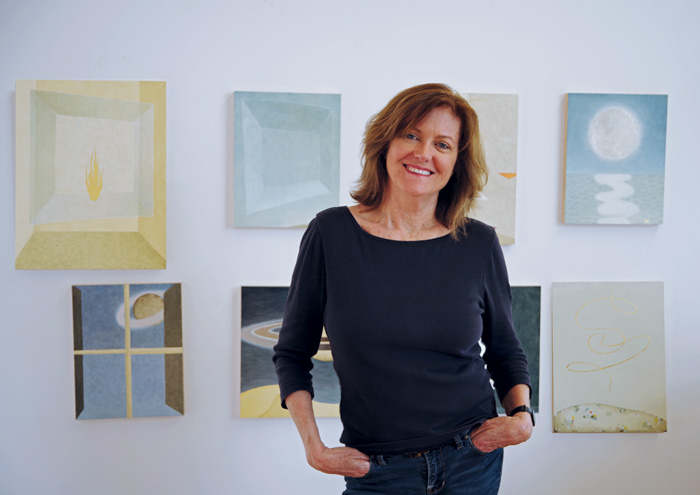Tabitha Vevers
Every inch the urban painter in fitted jeans and a black tee, Tabitha Vevers, accompanied by Sadie, her lively mixbreed dog, leads the way to her studio in Porter Square, Cambridge. Once home to the Payne Elevator Factory, the red brick building is now a hub of artist work/live lofts, each framed with rough-hewn beams and enviable 25-foot ceilings. She and her husband, artist/photographer Daniel Ranalli, retrofitted their space to include two generous studios. Communal areas are lined with paintings, sculptures and drawings. There are Ranalli’s abstract black-and-white images and one of Vevers’ large early fresco-like paintings with broad areas of color and abstract elements.
Tabitha Vevers in her Cambridge loft studio. On the wall are paintings from Seeking Symmetry which will be included in an upcoming show at Albert Merola Gallery this summer. Photo: Daniel Ranalli.
Napoleon’s Retreat, a painting by her father, Tony Vevers, shows the French general on horseback, trotting along an ocean (“Napoleon on the Outer Cape,” Vevers comments). A sculptural box construction by her mother Elspeth Halvorsen framing a barnacle-crusted driftwood branch, its base a two-inch plaster figure, hangs nearby. “I think of it as a mermaid and the barnacles as bubbles floating up,” Vevers says. The family, a central part of a community of artists, was based in Provincetown, MA, in an art-filled home that once belonged to Mark Rothko.
The ascension to Vevers’ third floor studio is via a tightly coiled spiral stair. She makes a circular gesture with her right index finger to signal the climb, a gesture “that everyone does,” she says, laughing. The coil motif returns in one of Vevers’ new paintings. These are dedicated to 90-year-old Halvorsen, in precarious health as the paintings evolve. The series, slotted for late August at the Albert Merola Gallery in Provincetown, is Seeking Symmetry. This alliterative title references Halvorsen’s quest for equilibrium in her mixed-media boxes (often compared to Joseph Cornell’s shadow boxes), as well as Vevers’ sense that she is cycling back to her own earlier work. Studying Giotto’s pre-Renaissance frescos devotional narratives, coupled with learning the fresco technique at the Skowhegan School of Painting & Sculpture, were early inspirations.
Vevers is well known for painstakingly portraying the female experience from a woman’s point of view in both her figurative, narrative oil paintings and her Lover’s Eye series, in which women’s eyes are appropriated from art historical sources—from Édouard Manet to Man Ray. Exquisitely painted on Ivorine (a synthetic ivory), the early eye portraits were a focal point of Vevers’ mid-career retrospective in 2009 at the deCordova Sculpture Park and Museum in Lincoln, MA. Examples of all five of the Lover’s Eyes series from the past 20 years will be reunited this fall in a show at the Gibbes Museum of Art, Charleston, SC.
The personal, meditative energy of Vevers’ narrative paintings create a sense of place and experience, both familiar and dystopian (her post-apocalyptic Eden Series proposes a time when binary gender is replaced by humanoids, who cope with climate change by sprouting unpredictable body parts). In Vevers’ widely exhibited Shiva Series, women engage brightly dappled lobsters in surprising, erotic trysts. “They started out being about breaking through a hard male exoskeleton to the tenderness within, but also celebrate those extra limbs and the push-pull of relationships.” She adds, “The water was a natural part of my environment growing up—I probably learned to swim and walk at the same time.”
A dozen pieces making up Seeking Symmetry are complete or in process the afternoon of our studio visit. Vevers has all along carefully staged her figures—what’s striking in Seeking Symmetry is the absence of figures and a new, radical abstraction. In The Vastness of Space, glowing fresco-like paintings are inscribed in loose wobbly lines within the box shape of Halvorsen’s constructions, “exploring the dynamic between cosmic space and containment,” Vevers says. In Spirit House, symmetry is upended. The gold leaf that Vevers has long incorporated now appears center stage, referencing the polished metals her mother is known for. Painted in thin layers of translucent brushstrokes, boxes float within boxes to suggest endless mirroring— while “flames” of gold leaf leap into creamy yellow space. We pause at Stairway. Triangular, translucent shapes float like clouds buffeted by light wind. A thin, gold spiral hovers vertically through the surface, signifying ascent.
Tabitha Vevers
tabithavevers.com
Susan Rand Brown is a poet, art critic and frequent contributor to Art New England. She also writes for Provincetown Arts and The Provincetown Banner.

